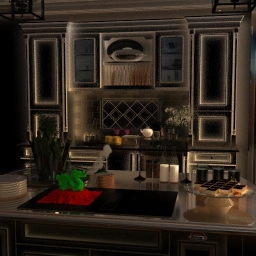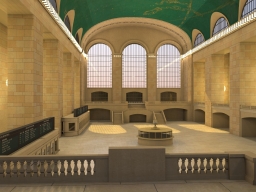Lightcuts
Cornell University
 |
+ |
 |
= |
 |
| Standard VPL method |
|
Bidirectional estimators |
|
Our result (BDLC) |
Abstract: Scenes modeling the real-world combine a wide variety of phenomena including glossy materials, detailed heterogeneous anisotropic media, subsurface scattering, and complex illumination. Predictive rendering of such scenes is difficult; unbiased algorithms are typically too slow or too noisy. Virtual point light (VPL) based algorithms produce low noise results across a wide range of performance/accuracy tradeoffs, from interactive rendering to high quality offline rendering, but their bias means that locally important illumination features may be missing.
We introduce a bidirectional formulation and a set of weighting strategies to significantly reduce the bias in VPL-based rendering algorithms. Our approach, bidirectional lightcuts, maintains the scalability and low noise global illumination advantages of prior VPL-based work, while significantly extending their generality to support a wider range of important materials and visual cues. We demonstrate scalable, efficient, and low noise rendering of scenes with highly complex materials including gloss, BSSRDFs, and anisotropic volumetric models.
Single-pass Scalable Subsurface Rendering with Lightcuts
Adam Arbree, Bruce Walter, and Kavita Bala
Eurographics 2008
2nd place in the Guenther Enderle Award for Best Student Paper
Download: [ Paper PDF ]
Abstract: This paper presents a new, scalable, single pass algorithm for computing subsurface scattering using the diffusion
approximation. Instead of pre-computing a globally conservative estimate of the surface irradiance like previous
two pass methods, the algorithm simultaneously refines hierarchical and adaptive estimates of both the surface
irradiance and the subsurface transport. By using an adaptive, top-down refinement method, the algorithm directs
computational effort only to simulating those eye-surface-light paths that make significant contributions to the
final image. Because the algorithm is driven by image importance, it scales more efficiently than previous methods
that have a linear dependence on translucent surface area. We demonstrate that in scenes with many translucent
objects and in complex lighting environments, our new algorithm has a significant performance advantage.
Multidimensional Lightcuts
Bruce Walter, Adam Arbree, Kavita Bala, and Donald P. Greenberg
SIGGRAPH 2006
Download: [ Paper PDF ]
Abstract: Multidimensional lightcuts is a new scalable method for efficiently rendering rich visual effects such as motion blur, participating media, depth of field, and spatial anti-aliasing in complex scenes. It introduces a flexible, general rendering framework that unifies the handling of such effects by discretizing the integrals into large sets of gather and light points and adaptively approximating the sum of all possible gather-light pair interactions.
We create an implicit hierarchy, the product graph, over the gatherlight pairs to rapidly and accurately approximate the contribution from hundreds of millions of pairs per pixel while only evaluating a tiny fraction (e.g., 200–1,000). We build upon the techniques of the prior Lightcuts method for complex illumination at a point, however, by considering the complete pixel integrals, we achieve much greater efficiency and scalability.
Our example results demonstrate efficient handling of volume scattering, camera focus, and motion of lights, cameras, and geometry. For example, enabling high quality motion blur with 256× temporal sampling requires only a 6.7× increase in shading cost in a scene with complex moving geometry, materials, and illumination
Links:
Lightcuts: A Scalable Approach to Illumination
Bruce Walter, Sebastian Fernandez, Adam Arbree, Kavita Bala, Michael Donikian, and Donald P. Greenberg
SIGGRAPH 2005
Download: [ Paper PDF ]
Abstract: Lightcuts is a scalable framework for computing realistic illumination. It handles arbitrary geometry, non-diffuse materials, and illumination from a wide variety of sources including point lights, area lights, HDR environment maps, sun/sky models, and indirect illumination. At its core is a new algorithm for accurately approximating illumination from many point lights with a strongly sublinear cost. We show how a group of lights can be cheaply approximated while bounding the maximum approximation error. A binary light tree and perceptual metric are then used to adaptively partition the lights into groups to control the error vs. cost tradeoff.
We also introduce reconstruction cuts that exploit spatial coherence to accelerate the generation of anti-aliased images with complex illumination. Results are demonstrated for five complex scenes and show that lightcuts can accurately approximate hundreds of thousands of point lights using only a few hundred shadow rays. Reconstruction cuts can reduce the number of shadow rays to tens.
Links:











